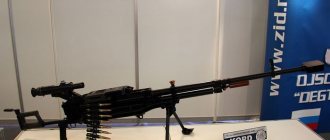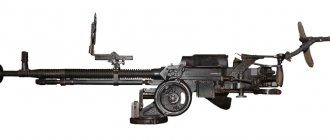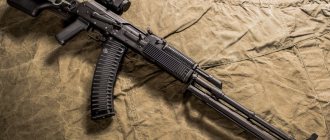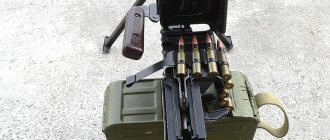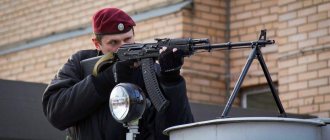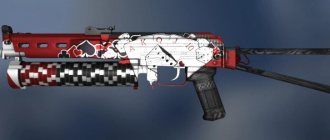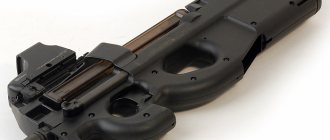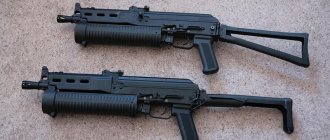A machine gun capable of relatively strong continuous fire
| This article requires additional links for verification . |
The M2 Browning machine gun weighs 58 kg (128 lb) with tripod.
Heavy machine gun
or
HMG
is a belt-fed machine gun that is fired entirely by powered/magnum cartridges and is designed for significantly heavier than light, medium or general purpose machine guns. [1] As their name suggests, heavy machine guns are typically not carried by infantry and therefore require mounting on a weapons platform to be operationally stable or tactically mobile, have greater firepower, and typically require a team of operational and maintenance personnel. service.
There are two generally recognized classes of weapons related to heavy machine guns. The first is a World War I weapon that was defined as "heavy" due to the weight and bulk of the weapon itself, making it difficult for infantrymen to move on foot. The second are the heavy-caliber (12.7x99mm, 12.7x108mm, 14.5x114mm or larger) machine guns pioneered by John Browning with the M2 machine gun and designed to increase effective range, penetration, and destructive power against cover. , vehicles, aircraft light buildings/fortifications beyond the standard caliber cartridges used in battle rifles and medium or general purpose machine guns, or intermediate cartridges used in assault rifles, light machine guns, and automatic combat weapons, but also have heavy recoil during operation.
Classification [edit]
The term was originally used to refer to a generation of machine guns that came into widespread use during the First World War. These cartridges fired standard rifle cartridges such as 7.92 Mauser, .303 British, or 7.62×54mmR, but featured heavy construction, sophisticated mountings, and water-cooling mechanisms that allowed continuous automatic fire at long range with superior accuracy. However, these advantages came at the cost of being too bulky to be moved quickly and also requiring them to be operated by a team of several soldiers. So in this sense, the "heavy" aspect of a weapon refers to its size and ability to withstand fire, not the caliber of the cartridge. The best example of this class of weapon is the Maxim pistol, invented by American inventor Hiram Maxim. [2] The Maxim was the most common machine gun of World War I, variants of which were used simultaneously by three separate warring countries (Germany with the MG 08, Britain with the Vickers, and Russia with the PM M1910).
DShK in a heavy role
The modern definition refers to a class of heavy-caliber (usually 0.50 or 12.7 mm) machine guns pioneered by John Moses Browning with the M2 machine gun. [3] These weapons are designed to increase range, penetration, and destructive power against vehicles, buildings, aircraft, and light fortifications beyond the standard rifle calibers used in medium or general purpose machine guns or the intermediate cartridges used in light machine guns. In this sense, the "heavy" aspect of a weapon refers to its superior power and range compared to light and medium caliber weapons in addition to its weight. This class of machine guns saw widespread use during World War II, when the M2 was widely used in fortifications, on vehicles, and in aircraft by American troops. A similar capability of the GMG was later fielded by the Soviets in the form of the Degtyarev DShK in 12.7×108mm. The ubiquitous German MG42 general purpose machine gun, while well suited for anti-infantry use, lacked the M2's hardening and anti-vehicle capabilities, which was noted and condemned by the Germans. The continuing need for a longer range anti-material machine gun to bridge the gap between purely anti-personnel and purely anti-material weapons has led to widespread adoption and modernization of the class, and most countries' militaries have become equipped with some type of AT.
Currently, machine guns with a caliber of less than 10 mm are generally considered medium or light machine guns, and machine guns larger than 15 mm are usually classified as autocannons rather than heavy machine guns.
History[edit]
In the late 19th century, Gatling guns and other externally powered weapons such as Nordenfelt often came in a variety of calibers, such as 0.5 inch and 1 inch. Due to the fact that they had multiple barrels, overheating was not as much of an issue, but they were also quite heavy.
When Maxim developed his recoil-powered single-barrel machine gun, his first basic design weighed a modest 26 pounds (11.8 kg) and fired a .45-inch rifle-caliber bullet from a 24-inch barrel. A famous photo of Maxim shows him lifting it with one hand using a 15-pound (6.8 kg) tripod. It was similar to modern medium machine guns, but could not be fired for long periods of time due to overheating. As a result, Maxim created a water jacket cooling system that allows it to burn for a long time. However, this added significant weight, as did the switch to more powerful rifle cartridges.
Thus, there were two main types of heavy rapid-fire weapons: hand-operated multi-barrel machine guns and single-barrel Maxim cannons. By the end of the 19th century, many new designs were developed, such as the M1895 Colt–Browning and Hotchkiss, gas- or recoil-powered. Additionally, instead of a heavy water jacket, new designs introduced other types of barrel cooling, such as barrel replacements, metal fins, heat sinks, or some combination thereof.
Design[edit]
Wheeled heavy machine gun DShK.
MG 08 (7.92 mm) system and crew circa 1931
Machine guns were divided into heavier and lighter designs. Later water-cooled Maxim pistols and their MG 08 and Vickers derivatives, as well as the American M1917 Browning machine gun, were very significant weapons. The .303 Vickers, for example, weighed 33 lb (15 kg) and was mounted on a tripod, bringing the total weight to 50 lb (23 kg). Heavier designs could, and in some cases did, fire for days on end, mostly in fixed defensive positions to repel infantry attacks. These machine guns were usually tripod-mounted and water-cooled, and a well-trained crew could fire continuously for several hours if provided with sufficient ammunition, spare barrels, and cooling water. Carefully placed heavy machine guns could stop an attacking force before they reached their target.
Light machine guns[edit]
However, during the same period, a number of lighter and more portable air-cooled designs were developed, weighing less than 30 lb (15 kg). During the First World War they were to be as important as heavier designs and were used to support infantry in attack, on aircraft and on many types of vehicles.
The lightest of the new designs could not conduct continuous automatic fire, since they did not have water jackets and were fed from relatively small magazines. Essentially bipod machine guns, weapons such as the Lewis Gun, Chauchat and Madsen were carried by a single soldier but were designed for single fire and burst fire.
Medium models[edit]
Medium designs offered greater flexibility, being fitted with a bipod in the light machine gun role or mounted on a tripod or other weapon as medium machine guns. An example is the 27.6 lb (12.2 kg) Hotchkiss M1909 machine gun, equipped with a mini-tripod and using interlocking 30-round ammunition rails, but there was also a belt-fed version.
This type of multi-purpose machine gun was further developed and later received names such as "general purpose machine gun" and later "universal machine gun", and eventually supplanted water-cooled designs. These later designs used quick-change barrel replacement to reduce overheating, further reducing the weapon's weight but at the cost of increasing the soldier's workload due to the additional barrels. Some earlier designs, such as the Vickers, had this feature, but this was mainly due to barrel wear as they typically used water cooling. It was in the 1920s and 1930s that quick barrel changes for cooling became more popular in weapons such as the ZB vz. 30, Bren, MG34 and MG42.
US .50 heavy machine gun developments - Browning M2, Browning M2E2 Quick Change Barrel, XM806 .50 caliber light machine gun (LW50)
Vladimirov PKP KPV KPVT 14.5 heavy machine gun (USSR/Russia)
Vladimirov's KPV-14.5 heavy machine gun in the PKP version on a Kharykin wheeled machine gun.
Vladimirov's KPV-14.5 heavy machine gun in the PKP version on a Kharykin wheeled machine gun, left view.
Vladimirov's KPV-14.5 heavy machine gun in the PKP version on a Kharykin wheeled machine gun, view of the breech of the weapon. The optical sight is installed abnormally.
Anti-aircraft machine gun mount ZPU-4 with four KPVT machine guns.
Large-caliber machine gun Vladimirov tank KPVT.
Caliber
14.5x115 mm
Weight 49
kg (KPV machine gun body) + 105 kg (Kharykin wheeled machine gun) or 39 kg (Baryshev tripod machine); 52 kg KPVT
Length
2000 mm
Barrel length
1350 mm
Feeding
belt 40 or 50 rounds Rate of fire 600 rounds per minute
The development of large-caliber machine guns chambered for particularly powerful 14.5mm cartridges, originally created in the USSR for anti-tank rifles, began in 1942 due to numerous demands from the troops. The main purpose of such a heavy machine gun was to combat lightly armored enemy vehicles (light tanks and armored personnel carriers), unarmored ground vehicles and enemy aircraft. In 1944, it was decided to develop the design of the machine gun proposed by Vladimirov, but the fine-tuning of the machine gun and installations for it was delayed and Vladimirov’s heavy machine gun was adopted for service only in 1949, in the version of an infantry machine gun on a Kharykin wheeled machine (under the designation PKP - Heavy Infantry Machine Gun Vladimirov system), as well as in the anti-aircraft version on several land and sea installations, which each had one, two or four Vladimirov machine guns. In 1955, a tank version of the Vladimirov KPVT machine gun appeared, which replaced the KPV / PKP in production and was used both for arming armored vehicles (BTR-60D, BTR-70, BRDM) and in anti-aircraft machine gun mounts ZPU-1, ZPU-2 and ZPU-4 . The anti-aircraft version of the KPV was used during combat operations in Vietnam; in addition, these machine guns were widely used by Soviet troops in Afghanistan and during the Chechen campaigns. Copies of KPV machine guns were produced under license in Poland and China. Until recently, Vladimirov’s heavy machine gun was the most powerful weapon in its class (caliber less than 20mm), but several years ago China developed its own version of the machine gun chambered for the original 14.5x115 cartridge. Thanks to a powerful cartridge with an armor-piercing bullet weighing 60 grams and an initial speed of 1030 m/s (muzzle energy of about 32,000 Joules), the KPV penetrates 32 mm of steel armor at a range of 500 meters and 20 mm of armor at a range of 1000 meters.
The Vladimirov KPV-14.5 heavy machine gun uses automatic operation using recoil energy with a short barrel stroke. The barrel is locked at the moment of firing by rotating the clutch attached to the bolt; the inner surface of the coupling has lugs in the form of segments of intermittent threads, which, when rotated, engage with the corresponding lugs on the breech of the barrel. The rotation of the coupling occurs when the transverse pin interacts with the shaped cutouts in the receiver. The barrel is quick-changeable, enclosed in a perforated metal casing and removed from the body of the machine gun along with the casing, for which there is a special handle on the casing. The cartridges are fed from a metal strip with a closed link, assembled from loose pieces for 10 cartridges each. The pieces of tape are connected using a chuck. The standard belt capacity is 40 cartridges for PKP and 50 for KPVT. The feeding of cartridges from the belt into the barrel is carried out in two steps - first, a special extractor on the bolt rollback removes the cartridge from the belt back, after which the cartridge is lowered to the chambering line and, as the bolt rolls forward, is sent into the barrel. Spent cartridges are ejected down and forward through a short tube on the receiver; The spent cartridge case is pushed out of the grooves holding it on the shutter mirror by the next cartridge or a special lever - the rammer (for the last cartridge in the belt). Shooting is carried out from an open bolt, with automatic fire only. The trigger mechanism is usually located on a machine or installation; in the infantry version, the controls on the machine include two vertical handles and a release button between them; in a tank machine gun, it is equipped with a remote electric trigger.
In the infantry version, the machine gun was mounted on a wheeled machine with sliding frames or on a tripod machine, in the anti-aircraft version - on various installations with guidance drives and special sights. On armored vehicles, the KPVT was usually used as the main weapon of armored personnel carriers and reconnaissance vehicles, being installed in the turret. On a number of experimental heavy tanks developed immediately after the Second World War, the KPVT was supposed to be installed as a twin gun or as an anti-aircraft gun on the turret.
World War II and later[edit]
Heavier designs continued to be used during World War II and into the 1960s, but were gradually abandoned in favor of air-cooled designs. Mediums were now used both as medium machine guns on tripods and as light machine guns on bipods. This was possible in part because the heavy static machine gun position was not a very effective tactic in vehicle-centric warfare, and significantly lighter air-cooled designs could nearly match the capabilities of water-cooled versions.
Gatling-type machine guns such as the Minigun and GShG-7.62 reappeared after World War II. They are commonly installed on ships and helicopters due to their weight and large ammunition requirements (due to their extremely high rate of fire). However, the need for continuous automatic fire on the ground is currently almost entirely satisfied by medium-sized air-cooled vehicles. pistols.
Machine guns
Having first appeared at the end of the 19th century, machine guns clearly showed themselves in the Anglo-Boer War, and by the time the First World War began they had gained well-deserved popularity.
A machine gun is a group automatic rapid-fire weapon of infantry squads, platoons and companies. In addition to infantry, machine guns can be used as the main or auxiliary weapon on armored vehicles, helicopters, and airplanes. Machine guns can be used from light folding bipods (light and single machine guns), from a wheeled or tripod machine - single, easel and heavy (large-caliber) machine guns. Machines can be conventional (for use against ground targets), anti-aircraft (for use against air targets) and universal. The weight of the machine for a modern single machine gun is 4-15 kg, for a large-caliber one - up to 20-25 kg.
Machine guns are usually divided into: light or hand-held, used with a bipod or hand-held and using the same ammunition as assault rifles in service, and, often, created on their basis (examples - RPK, created on the basis of AK, or AUG /hbar, based on Steyr AUG). Most modern light machine guns are magazine-fed, and can use both high-capacity magazines (up to 75-100 rounds) and magazines from standard machine guns (assault rifles). Single machine guns are used both from a bipod and from a machine gun; as a rule, they use more powerful rifle cartridges (7.62x54mm in the USSR/Russia, 7.62mm NATO, etc.). The effective firing range of single machine guns is up to 700-800m from a bipod and up to 1100-1200m from a machine gun. Most single machine guns are fed using a belt (capacity is usually from 100 to 250 rounds). Typical single machine guns are the Soviet/Russian PK/PKS, the American M-60, the Belgian FN MAG (in service with more than 20 armies of the world), the German Mg.42 and the Mg.3 created on its basis, and others. Large-caliber machine guns have a caliber from 12.7mm to 14.5mm, and are used only from a machine or mounted on equipment. Belt feeding, belt capacity is usually 50 rounds. The most typical examples are the American Browning M2 machine gun (.50 or 12.7x99mm caliber), adopted for service in 1933 and, in various modifications, in service with all NATO countries.
Multi-barreled systems, otherwise called Gatling machine guns (named after the 19th century American designer who created a multi-barrel manually operated canister gun), deserve special attention. Through the efforts of Hollywood “warriors”, these systems have turned in the minds of many into a type of hand weapon (see the films “Terminator”, “Predator”). In fact, such systems are used (in fact, in the armed forces of different countries) mainly for installation on airplanes and helicopters. Thus, the “Minigun” (Minigun M-134, GAU/2) shown in the mentioned films is the weapon of such US helicopters as UH-1, AH-1G, OH-6 and others. Such a machine gun cannot be used as a light machine gun for the following reasons: 1) with a rate of fire of 4-6 thousand rounds per minute, not a single person can withstand the recoil 2) with such a rate of fire, an ammunition load of thousands (tens of thousands!) of rounds is required, and such ammunition will not one person will not carry it away and 3) such systems (American, at least) require power supply (several powerful car batteries, at least) (domestic systems, for example, a 4-barrel GShG of 7.62mm caliber, use the energy of powder gases to drive automation ).
